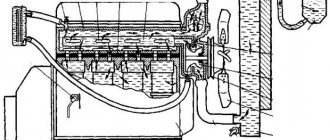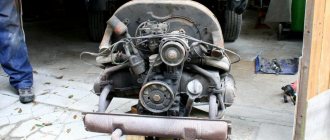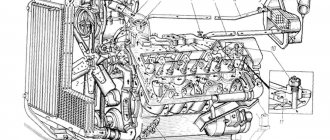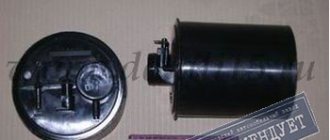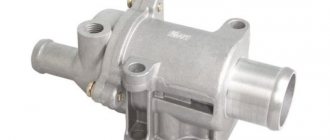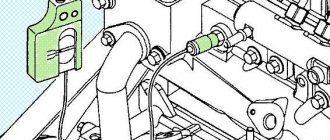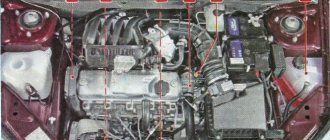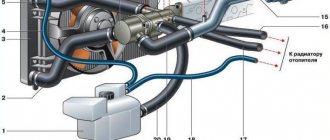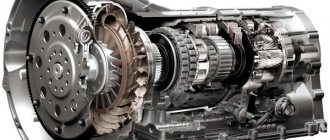The automatic transmission radiator serves to cool the constantly moving and rubbing gearbox mechanisms. Without it, it is impossible to imagine the normal operation of the gearbox. Since the transmission fluid heats up in the automatic transmission to 80 degrees, and in the summer the temperature rises even higher. Therefore, having one standard radiator in an automatic transmission is not always enough.
Normal operating temperature of automatic transmission
The technical documents for any gearbox say that the normal operating temperature of the transmission is considered to be between 60 and 90 degrees Celsius. It is achieved due to the installed cooling system in the automatic transmission. If there were no cooling device, the temperature during operation of the automatic transmission would not drop below 100 degrees.
Although ATF has become completely synthetic, when heated up strongly, they cannot retain their lubricating properties for a long time.
Automatic transmission cooling circuit
The cooling system diagram for any automatic transmission is as follows:
- pump. This unit creates pressure in the system and pumps oil from the moving parts of the box into a special hopper;
- oil receiver This is the same bunker. Consists of a rectangular body with pipes on both sides. It is usually located inside the radiator or at the bottom of the sump. Thanks to this location, the liquid is effectively cooled;
- filter. Usually made of metal mesh, less often of synthetic material. Serves to clean fluid from wear particles of moving mechanisms.
Attention!
Some car modifications are equipped with larger heat exchangers for greater cooling efficiency. Since the automatic transmission is cooled due to passive cooling through the car radiator, experienced car owners advise installing additional cooling devices. About other reasons for installing an additional automatic transmission radiator in the next block.
Read
Which automatic transmission is the most reliable and best, rating of automatic transmissions
Reasons for installing an additional automatic transmission radiator
The reasons for constructing an additional automatic transmission cooling unit are the following:
- the oil in the automatic transmission overheats and loses its properties;
- Frictions are soft and hard. Soft parts become soft due to overheating. Soft friction discs can no longer interact normally with planetary gears. As a result, speed transfers jump or, conversely, disappear. Also, soft clutches are quickly destroyed due to overheating;
- Solenoids often fail. This is also one of the reasons for exposure to high temperature. If in past years solenoids were made entirely of metal, now plastic impurities are added. Therefore, the solenoids began to burn frequently;
- wiring is on. The high temperature causes the wires to melt.
If the cooling of the automatic transmission is weak, then the above reasons may only be the beginning of the destruction of the gearbox. Therefore, installing an additional radiator on an automatic transmission is necessary if the car owner does not want to change the gearbox every month.
The harmful effects of overheating
Now I want to talk about the harmful consequences of fluid overheating, using the example of an automatic transmission.
- First of all, the oil itself suffers; its threshold is approximately 120 - 130 degrees Celsius. Often, in traffic jams (especially in summer) or during intense (sharp driving modes), the automatic transmission can heat up to critical temperatures. And this is 120 - 130 degrees! The oil begins to lose its properties, literally burns, and accordingly its properties are lost, which has a detrimental effect on many automatic transmission components.
- Friction discs . As we have already told you (follow the link), there are soft and hard elements. So, soft ones from high temperatures (if it exceeds 100) lose their properties, I would even say they deteriorate faster. They definitely need to be refrigerated.
- Valve block and solenoids. The valve body is a kind of oil distributor in the box, and the solenoids close and open the channels inside (I won’t focus on the work now). So, if previously solenoids were often made only of metal, now they are often made of plastic or using plastic parts. High temperatures are simply destructive for them. There are also cases when the valve body itself overheats, and “specifically” it even reaches the point where the metal turns blue
- Wiring. There is wiring inside the machine; it can also simply melt due to high temperature.
Actually, these are only the initial reasons, but there may be much more of them, including the destruction of planetary gears, due to the fact that the oil has lost its properties. That is, there is no normal lubrication. As you can see, a cooling radiator is simply necessary, but often NOW not all manufacturers configure cooling well.
Cooling radiator built into the main radiator
Special built-in cooling devices are sold. They consist of the cooling device itself and a tube that is washed with antifreeze or other coolant from the engine cooling system. This tube has a baffle inside that prevents engine coolant and oil from mixing.
Such devices are quite suitable for internal combustion engines up to 3 liters. However, if the engine displacement exceeds this figure, then the engine is high temperature. This means he can feel fine at 105 degrees. This temperature is not recommended for automatic transmissions.
Another disadvantage is the area of the tube built into the unit. She's too small. Therefore, the car owner cannot avoid overheating. If such an area is enough for a new car, then after driving hundreds of thousands of kilometers, plaque and dirt will form on the walls of the tube. Along with changing the oil and filter, the car owner will have to change and clean the engine cooling system.
Read
Automatic transmission repair dp0 al4 Peugeot 307
Therefore, the way out of this situation is to install an additional automatic transmission radiator.
Which additional radiator to choose
First of all, it is worth choosing this element with a reserve. To do this, you need to determine the cooling area of the standard cooling system and add 20-40% to this value. Additionally, you can buy a temperature sensor that is glued to the body of the “machine” itself or the pallet. In this case, you can find out the maximum temperature of the working fluid and determine the dimensions of the additional radiator.
The radiators themselves for automatic transmissions are:
- Tubular. Such products are characterized by minimal hydraulic resistance. Their internal cavities are less likely to become clogged with dirt. Even if this happens, the products are self-cleaning and easy to wash. The connection is made from the side of the standard radiator. Such radiators (4-row) are mainly used for sedans with an engine capacity of up to 2 liters, which are not intended for use with trailers and do not drive in difficult conditions. More powerful cars (volume up to 3 liters) require 6-row radiators. And for those who drive a loaded car, 8-row models are suitable.
- Lamellar. During the first few years of use, such products are 10-30% more effective than their tubular counterparts. In addition, they serve as filters that trap large pieces of dirt, metal and plastic chips, as well as paper particles. Plate radiators are made of painted aluminum, so they look more aesthetically pleasing.
Also today on sale are models without a turbulence spiral for automatic transmissions, which get very hot, and the oil pump has increased performance. However, such models are not popular, as they are quite “picky” about oil.
Installing an additional radiator
Owners of cars such as Chevrolet and the like have problems with automatic transmission heating. Because the operating temperature of the engine in these cars reaches 115 degrees. And the gearbox does not have a separate automatic transmission oil cooler. As a result, the car's automatic transmission, not yet having traveled its legal 60,000 kilometers, begins to kick, lose speed, and the car owner receives a dilapidated box for repair.
In this case, the automatic transmission of this car will be saved by installing a universal automatic transmission radiator. The car's automatic transmission will stop heating when the car's engine picks up speed above the set points at which the transmission fluid will remain at the optimal temperature. The duration of production of mechanical parts will increase, which means that from repair to repair the car will gain the required amount of kilometers.
Additional radiators are selected after diagnostics at a service station. It is necessary to find out how much heating occurs in the box in order to select the most accurate device.
Types of radiators:
| Name | Company | Size(mm) | Engine capacity (l) |
| Tubular, four-row | Hayden, Tranny Cooler | 222x127x19 | Up to 2 |
| Tubular, six-row | Hayden, Tranny Cooler | 222x190x19 | Until 3 |
| Tubular, eight-row (requires installation of a thermostat for operation in winter) | Hayden, Tranny Cooler | 308x254x19 | Over 3 |
| Lamellar | Hayden, Long | 305x279x19 | Until 6 |
Read
Basic malfunctions and errors of automatic transmission
How to install it yourself
Installing an additional radiator to cool the automatic transmission will not take much time. And an ordinary car enthusiast can do it without going to a service station.
Attention! As an additional cooling device, you must choose a reliable and high-quality device. They were briefly described in the previous block. Special ties should be sold complete with the device. Clamps, adapters, and special hoses are purchased for it that will withstand the circulation of hot transmission fluid.
The installation proceeds as follows:
- Remove the front bumper and left air duct.
- Secure the new radiator to the engine cooling unit using special ties. The location should be chosen behind the engine cooling grille. It will be blown with air from the fan.
- Hoses are put on pipes, the diameter of which can vary from 3.8 to 10 mm, and tightly secured with clamps.
- Connect the reinforced hoses to the factory ones through special adapters. If buying them is expensive for the car owner, then you can ask a turner friend to grind out an adapter tube.
- Add transmission fluid to completely fill the system with oil.
In addition to the automatic transmission radiator, you can also install a thermostat. It will help cool the system not always, but precisely at the right time.
Attention! The thermostat may be stuck. Then neither it nor the additional radiator will be of any use.
More details on how to install an additional radiator in the video:
Additional thermostat
Installing a thermostat will allow the automatic transmission oil cooler to regulate the temperature. In addition, the thermostat is a plus under the following environmental conditions:
- in winter, improves the heating of the machine;
- in the summer it cools the oil in the box better.
The operating principle of the thermostat is described in the table:
| Modes | Oil temperature | Circle of work |
| Staff | Up to 75 degrees | Small circle of circulation. The second device is not used. |
| Reinforced | Maintain temperature between 75 and 85 degrees | Large circle of circulation. An additional automatic transmission cooling radiator is activated |
Read
Automatic transmission gear selector: types, disassembly and repair
Cleaning the automatic transmission oil cooler
Those car owners who have a second radiator installed are advised not only to change the transmission fluid, but also to clean the cooling system and heat exchanger. Since it is susceptible to contamination, which leads to a decrease in efficiency.
In addition to cleaning, it is recommended to check the cooling pipes of the automatic transmission for rupture and for various deposits that will certainly appear during use. Breaks usually occur after hoses lose elasticity.
Attention! Experienced car owners advise replacing pipes after the car has driven 150,000 kilometers.
If everything is in order with the hoses, then you should check the radiator for blockages. Wear particles from parts can get stuck inside the radiator tubes through which the oil flows. Over time, they grow and narrow the permeability of the transmission fluid. And this increases the temperature during operation of the machine.
Attention! Blockages can lead to thermostat failure. Usually the valve jams and the fluid in both modes operates in a large circle of circulation.
To clean the cooling line, the car owner should take the following steps:
- Turn off the car engine.
- Disconnect the cooling pipes and the automatic transmission.
- Connect hoses from the cooling line cleaning device to the radiator pipes.
- Start the device.
- After several minutes of operation, disconnect the automatic transmission radiator from the cleaning unit.
- Attach an air compressor to it.
- Drive high pressure air through the radiator. This is called drying out the cooling system.
- After it is dried, the unit can be reconnected to the automatic transmission.
Despite the ease of using an additional cooling radiator for an automatic transmission, there are also pitfalls with this device.
Consequences of automatic transmission overheating
Overheating of the automatic transmission leads to failure of solenoids, clutches and other moving elements. In some cases, even 10 - 20 minutes of operation of the gearbox in overheating mode is enough, which leads to serious damage and the need for major repairs. That is why, at the first signs of overheating, as a rule, this is indicated by sensors built into the gearbox, it is necessary to turn off the car and transport it to a service station on a tow truck. This way you can avoid significant problems caused by prolonged operation of the gearbox at elevated temperatures. During long-term operation of the gearbox with an increased operating temperature, problems may arise with the geometry of the hydraulic plate and control unit. It should be remembered that a control unit that has failed due to overheating cannot be repaired and therefore requires an expensive replacement. It is for this reason that the car owner needs to closely monitor the condition of the gearbox and, when the first reports of oil overheating in the automatic transmission appear, contact a specialized service center.
Pitfalls of an additional radiator
Problem. The main problem is the winter season. Transmission fluid tends to thicken. Therefore, after installing an additional automatic transmission radiator, the oil needs to travel a much longer distance to fully warm up. This means that more time will be spent warming up the machine. Many car owners do not like to wait and start with a cold automatic machine. This leads to the fact that the thick liquid squeezes out the seals and the seal is broken. Oil starts dripping.
Solution. To make the oil heat up faster, you need to install a thermostat. But even its installation will not allow motorists to start from a cold start. Therefore, in any case, you need to be patient and wait until the automatic transmission warms up.
Problem. Cleaning the additional radiator. Purchase of equipment for cleaning the automatic transmission cooling system from dirt.
Solution . It is not necessary to buy a special pump. The following units can be used:
- dacha submersible. Minus – noisy work;
- stove The best choice. Silent, not afraid of dirt, can be used in damp rooms.
Problem . The cooling system is installed. But the temperature is still higher than expected.
Solution . The oil does not cool in this case for several reasons:
- Thermostat sticks;
- old transmission fluid. Replacement required;
- complete cleaning of not only the cooling system, but also the entire automatic transmission.
Problem . A large amount of oil needs to be added.
Solution . The existence of this problem is a myth. The volume of added oil will be equal to the volume of the radiator tubes and hoses connecting it to the automatic transmission.
Benefits of using an additional radiator
First of all, such a system will resist overheating. This means that the temperature of the working fluid will not exceed 80 degrees. Accordingly, the overall service life of the automatic transmission will increase.
Due to the fact that the transmission oil is cooled, the fluid lasts longer and does not burn out, so it can be safely changed after 60,000 km. Also, additional radiators prevent premature wear of the solenoids and valve body.
However, despite all the advantages of additional systems, they provide cooling throughout the entire time. This means that in summer the oil will not heat up too much, and in winter intensive cooling, on the contrary, will only bring additional problems. To solve this problem, it is enough to install one more element into the system.
